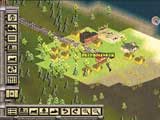 If SIMs are your bag, then
pack up and take a ride on the Railroad Tycoon II, the PlayStation offspring of the PC
bestseller. You are the chairman of your own railroad and connecting the world is your
manifest destiny. By linking cities and manipulating supply and demand, you forge an
empire made of steel. But the market is sometimes cruel, so a good head for business is
indispensable.
If SIMs are your bag, then
pack up and take a ride on the Railroad Tycoon II, the PlayStation offspring of the PC
bestseller. You are the chairman of your own railroad and connecting the world is your
manifest destiny. By linking cities and manipulating supply and demand, you forge an
empire made of steel. But the market is sometimes cruel, so a good head for business is
indispensable.There are 18 consecutive campaign levels, as well as a scenario setting
that lets you tailor your game maps and scenarios, and a sandbox version which allows you
to build a dream empire with no financial or industrial constraints. The game has three
difficulty settings (which actually make a difference!!), the ability to design a custom
setting for the financial and industrial models and revenue modifiers, and a tutorial mode
which gets you prepped for gameplay. Even if you’re an old hat at simulations,
it’s pretty important to check out the manual on this one. Even then you may still
not be prepared to be immediately successful with this game.
The campaign mode requires you to play through its individual scenarios in order, yet
allows you to move on even if you fail your objectives. You can come back and tackle them
later, but keep in mind that each escalates in difficulty, so sometimes persistence pays
off. One negative of the game pops up at this point, as you can’t save mid-level. If
you’ve got lots of time this isn’t a problem (an obsessive sim-ster will make
time, of course), but for those of us with limited playtime, this is a downer.
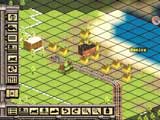 The cinema screens on this game were excellent and set a great tone for the
game. Many of these were black and white film clips, with a smaller number being animated.
The maps used during gameplay were well rendered and quasi-three dimensional (achieved
mostly through color rather than perspective), and it was easy to distinguish the
topographical features of the land. Each of the different types of buildings were unique and
easily recognizable as were the train compartments/cars and equipment.
The cinema screens on this game were excellent and set a great tone for the
game. Many of these were black and white film clips, with a smaller number being animated.
The maps used during gameplay were well rendered and quasi-three dimensional (achieved
mostly through color rather than perspective), and it was easy to distinguish the
topographical features of the land. Each of the different types of buildings were unique and
easily recognizable as were the train compartments/cars and equipment.
The beginning screens had accompanying music (banjo?), but during actual play only the
sound effects were present. I would have liked to have a lilting backdrop to help convey
mood and to alleviate some of the ‘heaviness’ that silence can bring after hours
of gaming. It also might have helped to keep things interesting to spectators who are not
as wrapped up in the game as the players.
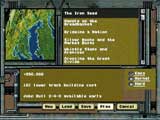 The translation from PC to console was handled fairly well as far as the set-up
for the control and navigation menus went. They functioned just as well as pull-down
menus, only causing confusion initially while navigating the sub-menus. The icons were
fairly recognizable concerning their function, and most of the screen was left for
landscape. The two things that I felt didn’t really work well for the console was the
movement in the main window view and the visual clarity of the text. A satellite map could
be used to move quickly from place to place if specific locations were known, but since
many times a person needed to discover these, the main window view had to be utilized for
the search. I found the movement hard to control—both jerky and runaway. As for the
text, the font and color that was used would have been fine for the PC situation where
most people are no more than three feet away from their monitor, but when a television set
can be across the room from the ‘comfy control couch,’ it makes even the keenest
eye have to strain.
The translation from PC to console was handled fairly well as far as the set-up
for the control and navigation menus went. They functioned just as well as pull-down
menus, only causing confusion initially while navigating the sub-menus. The icons were
fairly recognizable concerning their function, and most of the screen was left for
landscape. The two things that I felt didn’t really work well for the console was the
movement in the main window view and the visual clarity of the text. A satellite map could
be used to move quickly from place to place if specific locations were known, but since
many times a person needed to discover these, the main window view had to be utilized for
the search. I found the movement hard to control—both jerky and runaway. As for the
text, the font and color that was used would have been fine for the PC situation where
most people are no more than three feet away from their monitor, but when a television set
can be across the room from the ‘comfy control couch,’ it makes even the keenest
eye have to strain.
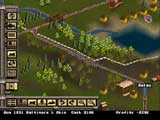 As with all games of this nature, there is an incredible amount of data to keep
track of. Not only do you build railways, you have to keep track of the stock market,
community goodwill (just to name a few), and always keep and eye on the bottom line. All
SIMs have a pretty high learning curve, but this one takes quite a while to get a handle
on. Most others are immediately engaging and allow you to do enough alternative actions
that you don’t get frustrated by your limitations. They also take pains to make the
gameplay more easily understandable for beginners.
As with all games of this nature, there is an incredible amount of data to keep
track of. Not only do you build railways, you have to keep track of the stock market,
community goodwill (just to name a few), and always keep and eye on the bottom line. All
SIMs have a pretty high learning curve, but this one takes quite a while to get a handle
on. Most others are immediately engaging and allow you to do enough alternative actions
that you don’t get frustrated by your limitations. They also take pains to make the
gameplay more easily understandable for beginners.
Railroad Tycoon II doesn’t seem to be thinking about beginning level players in
these respects. Perhaps this is because they suspect that the majority of people picking
up this title have played the PC version, are experts in the field of simulation, or are
railroad fanatics. They may be right, but it seems to me that this is shutting out a
broader audience that could enjoy this game. All it would take is a more step-by-step
tutorial which would illustrate the most simple elements of the game and give hints on
what actions are effective/necessary for a player to reach his or her objectives. They
could then scaffold the more difficult elements upon that information. It would create a how-to
rather than merely a near replica of the campaign mode. There are some actions a person
can take without really knowing what they’re doing (although those actions still have
repercussions in the game), but others leave beginning players feeling stymied,
inept—and very frustrated. There are plenty of things they could do at these
points, but they may have no idea that alternative options exist, let alone how to
accomplish them. The only option then is to go play in the ‘sandbox,’ which is
fun for a while, but doesn’t really make for a challenging or interactive game.
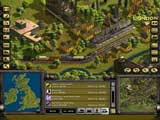 Although
there are some downers about Railroad Tycoon II, there are also some heavy hitters on the
positive side. One of this game’s most amazing strengths is its depth of detail and
its adherence to reality. It follows a historical model which affects the stock market,
geographic detail and product/equipment availability in regard to the time in which your
scenario is taking place. It also factors in sources outside your sphere of influence
which would affect you and the economy. With as much information as you learn about
history and business in this game, you could probably get away with calling it
educational. With all the choices, details, and variations in game play, no scenario will
play the same twice. This allows the game an unbelievable longevity.
Although
there are some downers about Railroad Tycoon II, there are also some heavy hitters on the
positive side. One of this game’s most amazing strengths is its depth of detail and
its adherence to reality. It follows a historical model which affects the stock market,
geographic detail and product/equipment availability in regard to the time in which your
scenario is taking place. It also factors in sources outside your sphere of influence
which would affect you and the economy. With as much information as you learn about
history and business in this game, you could probably get away with calling it
educational. With all the choices, details, and variations in game play, no scenario will
play the same twice. This allows the game an unbelievable longevity.
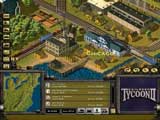 So
how did I come to the three star rating and what the heck does that mean to you, the
gamer? Well, if you like SIMs and have lots of patience to learn the ins and outs of this
world, this game is for you. Also, if you have a love for history in general and trains in
particular, you would love the realism that this game brings home. You are the
intrepid tycoon (with everything that entails), taking on the world to form a
transportation monopoly. However, if we look at the star rating as how many people in five
who played this game would really enjoy it, I’d have to say only three out of five.
It’s too selective in its difficulty level and its learning curve to be easily
accessible to the novice, and not all sim-sters would enjoy this specific set-up.
It’s not really flashy or full of surface excitement. So although this is fairly
solid in its construction and translation from the PC, it isn’t a game for everyone.
So
how did I come to the three star rating and what the heck does that mean to you, the
gamer? Well, if you like SIMs and have lots of patience to learn the ins and outs of this
world, this game is for you. Also, if you have a love for history in general and trains in
particular, you would love the realism that this game brings home. You are the
intrepid tycoon (with everything that entails), taking on the world to form a
transportation monopoly. However, if we look at the star rating as how many people in five
who played this game would really enjoy it, I’d have to say only three out of five.
It’s too selective in its difficulty level and its learning curve to be easily
accessible to the novice, and not all sim-sters would enjoy this specific set-up.
It’s not really flashy or full of surface excitement. So although this is fairly
solid in its construction and translation from the PC, it isn’t a game for everyone.

 If SIMs are your bag, then
pack up and take a ride on the Railroad Tycoon II, the PlayStation offspring of the PC
bestseller. You are the chairman of your own railroad and connecting the world is your
manifest destiny. By linking cities and manipulating supply and demand, you forge an
empire made of steel. But the market is sometimes cruel, so a good head for business is
indispensable.
If SIMs are your bag, then
pack up and take a ride on the Railroad Tycoon II, the PlayStation offspring of the PC
bestseller. You are the chairman of your own railroad and connecting the world is your
manifest destiny. By linking cities and manipulating supply and demand, you forge an
empire made of steel. But the market is sometimes cruel, so a good head for business is
indispensable.